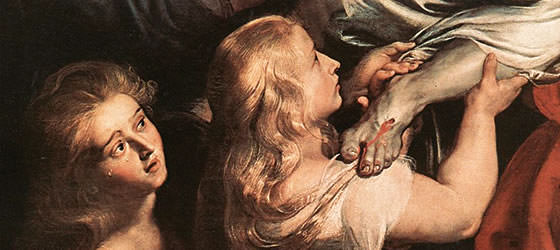
The worst thing that can happen to any Christian is for their experience of the cross to become bland. It’s understandable that this might happen when there are crosses everywhere. You find them on churches, schools, badges, uniforms, flags and even on hot buns. The cross is so familiar that we could pass by without recalling what it represents.
In the Spiritual Exercises, St Ignatius uses a strong expression to encourage people to draw closer to the reality of the cross. For him, the mystery of the cross was very much part and parcel of what he called the ‘pain, tears and torment’ of what Jesus went through. Its transcendence is found in the blood, sweat and degradation.
Two of the words Ignatius uses are emotional: tears and torment. Ignatius doesn’t want us to think about the passion. He wants us to be burdened by it. So the expression he uses is ‘labour’. We can’t understand the crucifixion. We can only labour as we carry the story into our own lives. At the end of the Spiritual Exercises, Ignatius uses the same expression again when he points out that God shows us love when he ‘behaves like one who labours’ for us.
Over the centuries, art has helped Christians to labour through the reality of the crucifixion. Some of the most effective paintings have been some of the most confronting. Among them is The Descent from the Cross (1611) by Peter Paul Rubens.
Rubens (1577 to 1640) was born in Germany, spent time in Italy and lived a good part of his life in Antwerp. He was an accomplished businessman. His artwork was in such demand that he had many paid assistants, some of whom became quite famous in their own right. He did very well for himself. Does this mean that his religious art was insincere, just because it was accompanied by a substantial payment. Not necessarily. The older we get, the more we understand that nearly all motives are mixed. Pope Francis seems to be calling the church to live with greater and greater complexity, to make our home in paradox and subtlety rather than shallow black and white teachings.
When it comes to someone like Rubens, we have to look beyond a patina of success. He was a professional. But there is more going on in his work than making money. Compare Rubens’ paintings of people in clothes to his nudes. His clothed characters tend to be proper and respectable, defined by their role in the world. They are neat and trim. His nudes, on the other hand, are voluptuous, untidy and fleshly. Indeed, the adjective rubenesque is sometimes used to describe chubby people when you don’t want to be coarse. In other words, Ruben believed that what happened beneath a professional exterior was more interesting and less predictable. It is hardly surprising that in The Descent from the Cross, Jesus is the only naked figure. He is the only one who has completely revealed himself.
Rubens liked to paint on a vast scale and his painting of Jesus being taken down from the cross is enormous. It is the size of a modern room, measuring about 4m by 3m. It is the central part of an installation in the Antwerp Cathedral. On the left had side as you look towards it, there is a painting of Mary’s visitation to Elizabeth. On the right hand side, there is an image of the presentation of Jesus to Simeon in the temple. These stories may seem a little out of place as they are not normally placed alongside the crucifixion. If you fold these pictures on their hinges, on their reverse side you will see images of St Christopher, the person who, in legend, is said to have carried the Christ child.
Once you start to think about it, the message becomes more clear. The visitation, the presentation and the tale of St Christopher are all stories about somebody carrying Jesus. More than that, they contain elements of somebody labouring to carry Jesus. This is the point Rubens is making about the body of Christ as it is taken down from the cross.
In the painting, Jesus is dead but still looks strong, even hefty. The superb muscle delineation is unusual for a study of death. But Rubens wants us to think that carrying Jesus is no easy task. Indeed, look at the solid nature of the scaffold around the cross. Look also at the physical strain being endured by St John, the figure in red. There is a diagonal of light which seems to pass right through the centre of the painting and into the world of the viewer.
Rubens wants us to think long and hard about what it means to carry the crucified body of Christ into the world. There are no casual observers in this picture. We are looking at lives being changed by the burden they have received. Every life is called to share part of the burden of the cross.
Michael McGirr is the author of many books including Ideas to Save Your Life (Nov 2021). Books That Saved My Life, Snooze: the Lost art of sleep, Bypass; The story of a road and Things You Get For Free. His religious books include Finding God’s Traces and Doorways into Hope and Joy at Advent and Christmas. He has much experience as a secondary teacher in the realm of Faith and Mission and currently works for Caritas Australia. He lives in Melbourne with Jenny and their three children.